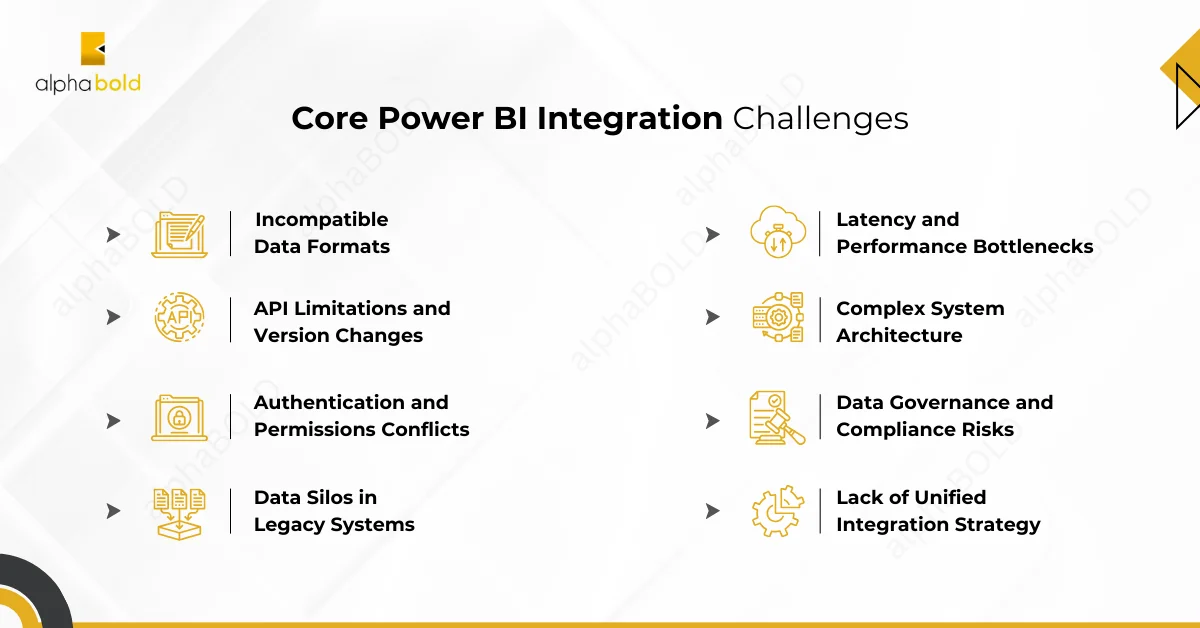Table of Contents
Introduction
As organizations move into 2026, C-level executives face evolving challenges in integrating Power BI into their operations. The landscape has shifted significantly, from traditional data quality and integration concerns to new AI governance demands and real-time processing requirements. According to PixelPlex, the business intelligence software market is projected to expand to $42.99 billion by 2030, reflecting a compound annual growth rate (CAGR) of 9.02% from 2024 to 2030. Power BI now competes in an ecosystem where artificial intelligence governance, data mesh architectures, and ethical compliance have become strategic imperatives. This updated article highlights both foundational Power BI integration challenges and new frontiers that emerged in 2025-2026, helping industry leaders transform these complexities into competitive advantages.
Power BI's Evolution: From BI Tool to AI-Driven Analytics Platform
Power BI’s significance has expanded dramatically in 2025-2026. Beyond traditional business intelligence, the platform has become an AI-integrated analytics engine. Key developments include:
Copilot Integration Across Environments: Copilot is now supported in embedded Power BI reports for SharePoint Online, allowing users to engage with the Copilot Report Pane directly within embedded experiences, and filtered report summaries enable Copilot to intelligently apply relevant filters for in-depth conversations.
AI-Native Data Modeling: DAX User-Defined Functions are now available, enabling code reuse across models, while calendar-based time intelligence tailored to specific business needs is in preview. These capabilities democratize advanced analytics for non-technical users.
Mobile-First Analytics: Copilot support is now available in Power BI Mobile apps on iPads and Android tablets, extending AI capabilities to more devices, enabling real-time decision-making on the go.
Direct Lake Performance: Performance improvements now deliver at least 50% faster modeling changes in Direct Lake semantic models, addressing latency concerns for large-scale analytics.
Core Power BI Integration Challenges
AI Governance and Explainability:
Challenge: As Power BI increasingly leverages AI through Copilot and automated insights, organizations now face a critical governance gap. The speed of adoption, creation of regulations, increased expectations of customers’ protection of their data, cost of replicating data due to AI, and the general risk landscape increased by Copilots will all contribute to AI governance adoption becoming mainstream in 2025.
Impact:
- Black-box AI decisions that cannot be audited or explained
- Compliance risks under emerging regulations like the EU AI Act
- Inability to demonstrate fairness and transparency in automated analytics
- Ethical concerns around biased algorithms influencing business decisions
Solution: Implement AI governance frameworks that ensure transparency and explainability. In 2025, the integration of AI into data governance processes will likely continue to grow with a significant shift toward ensuring that results of AI prompts can be explained and will adhere to ethics scrutiny. Establish audit trails for all Copilot-generated insights, document AI decision logic, and create oversight mechanisms for automated recommendations.

Real-Time Data Governance and Observability:
Challenge: Through 2026, two-thirds of enterprises will invest in initiatives to improve trust in data through automated data observability tools addressing the detection, resolution, and prevention of data reliability issues. Traditional batch-based governance models are insufficient for modern analytics.
Impact:
- Stale governance policies that cannot adapt to real-time data flows
- Data quality issues propagating undetected into dashboards and decisions
- Compliance violations with regulatory requirements for continuous monitoring
- Inability to quickly identify and resolve data anomalies
Solution: Transition from manual to automated, continuous data governance. Implement real-time data observability tools that automatically detect discrepancies, monitor data lineage continuously, and trigger alerts when quality thresholds are breached. Use cloud-based orchestration like Azure Data Factory to manage streaming data with built-in governance checks.
Seek Expert Guidance to Counter Power BI Integration Challenges
Schedule a free Power BI demo today and discover how our expert team can help you transform your data into actionable insights. We'll guide you through the entire process, from data integration and visualization to advanced analytics and reporting.
Request a DemoUnstructured Data Integration and GenAI Complexity:
Challenge: GenAI lives on unstructured data, text, images, videos, audios, as the most abundant source for generating new insights. The sheer volume and variety of unstructured data makes it extremely difficult to govern, manage, and secure.
Impact:
- Governance frameworks designed for structured data fail with unstructured sources
- Increased compliance risks when sensitive unstructured data is fed into AI models
- Higher costs and complexity in data preparation for GenAI integration
- Difficulty in applying consistent security controls
Solution: GenAI can eliminate the manual and tedious work of data governance by creating metadata labels, annotating lineage information, and augmenting data quality tasks including removing duplicate records and standardizing data formats. Implement AI-assisted data discovery and classification tools that automatically catalog and secure unstructured data before it reaches Power BI analytics pipelines.
Data Silos and Data Fabric/Mesh Integration:
Challenge: Legacy data silos persist, but 2026 introduces a new dimension: organizations must choose between centralized Data Fabric and decentralized Data Mesh architectures, or hybrid approaches.
Impact:
- Fragmented analytics across business units unable to share insights
- Difficulty deciding whether to consolidate data centrally or empower teams locally
- Increased complexity when bridging traditional silos with modern mesh architectures
- Competing governance models creating inconsistency
Solution: Businesses will increasingly align with the idea that they can, and perhaps should, implement and integrate data fabric and data mesh architectures together, bringing together disconnected data sources to improve data governance, discoverability, and access with the former, and decentralizing data ownership with the latter. Deploy a hybrid strategy using data lakes or staging areas for centralized preprocessing while enabling domain teams to manage their own datasets with centralized governance guardrails.
Incompatible Data Formats and Modern Connectors:
Challenge: While traditional format incompatibility remains, new database technologies and modern connectors introduce updated integration requirements.
Impact:
- Complex transformations still required for legacy data sources
- Performance bottlenecks when using older connector implementations
- Difficulty optimizing large datasets with legacy ODBC drivers
Solution: Advanced connector implementations now use modern technologies like Arrow Database Connectivity (ADBC) which efficiently fetches large datasets with minimal overhead and without serialization or copying, compared to older ODBC implementations that showed significant performance improvements in load times. Leverage updated Snowflake, Vertica, and Oracle connectors in Power BI that offer enhanced performance. Use DirectQuery and incremental refresh strategies to minimize data movement and transformation overhead.
Authentication, Permissions, and Sovereign AI Complexity:
Challenge: With data residency constraints and compute considerations becoming important to strategic planning, data controls and compute infrastructure requirements will drive new authentication and permissions architectures, particularly in highly regulated sectors like banking, insurance, life sciences, and healthcare.
Impact:
- Misaligned authentication across Power BI, cloud services, and on-premises systems
- Compliance failures when data residency requirements aren’t met
- Inability to enforce geographically-specific access controls
- Complexity managing multi-cloud environments with varying security standards
Solution: Configure Azure Active Directory (AAD) with role-based access controls that enforce regional data sovereignty. Implement row-level security that respects geographic boundaries and regulatory constraints. Document data residency compliance for each integrated system and audit cross-border data flows regularly.
You may also like: All About Azure Synapse Analytics and Its Machine Learning Experiences
Complex System Architecture and Hybrid Cloud Integration:
Challenge: Beyond traditional on-premises/cloud hybrids, 2026 brings multi-cloud complexity where organizations run Power BI across Azure, AWS, and other platforms simultaneously.
Impact:
- Data inconsistencies across multiple cloud providers
- Delays in synchronization between heterogeneous environments
- Vendor lock-in concerns limiting flexibility
- Increased operational complexity managing multiple authentication and encryption standards
Solution: Deploy Power BI Gateways for reliable on-premises data connectivity. Use cloud-agnostic orchestration tools and standardized data formats to maintain consistency. Implement a centralized metadata repository that tracks data lineage across all environments, enabling visibility and control regardless of where data resides.
Data Quality as a Governance Imperative:
Challenge: Organizations are enhancing data security (54%), improving data quality practices (48%), and updating data governance frameworks and developing new data policies (45%). Poor data quality has become a top-tier governance concern.
Impact:
- Cascading errors from source systems propagating through dashboards
- Business decisions based on inaccurate or incomplete data
- Regulatory violations when data quality issues affect compliance reporting
- Undermined trust in analytics platforms
Solution: Integrate data quality monitoring directly into Power BI pipelines using automated anomaly detection. AI-driven tools significantly improve data accuracy, consistency, and reliability, directly boosting decision-making capabilities, while machine learning simplifies compliance by automating tasks, reducing costs, and ensuring regulatory adherence. Establish data quality SLAs, monitor them continuously, and create automated remediation workflows for common data quality issues.
Data Masking and Privacy by Design:
Challenge: With the rise in hybrid and multi-cloud environments, businesses will increasingly need to secure sensitive data across diverse systems using data masking technologies that replace sensitive data with obfuscated or pseudonymized values.
Impact:
- Sensitive data exposed in development, testing, and analytics environments
- Compliance failures under GDPR, HIPAA, and emerging privacy regulations
- Inability to share masked datasets safely across teams
- Manual masking processes creating bottlenecks
Solution: Implement dynamic data masking that applies context-aware rules based on user roles and access patterns. Use real-time masking in Power BI to ensure sensitive data is obfuscated for unauthorized viewers while maintaining usability for legitimate analytics. Integrate masking policies into your data governance framework and audit masked data access continuously.
Struggling to Make Sense of your Data?
Schedule a Power BI demo with AlphaBOLD. Our experts will show you how to overcome common data challenges, such as data silos, slow reporting, and inaccurate insights. We'll demonstrate how to build a robust data solution that delivers the information you need to make informed decisions and drive business growth.
Request a DemoEmerging Trends: Building AI-Ready Data Architectures
From Data Governance to AI Governance:
The focus has shifted from traditional data governance to AI governance. Organizations that invest in AI governance, prioritize data accuracy, embrace synthetic data, and leverage automation will lead the way. This requires new skills, roles (like “agent ops” teams), and governance structures designed for AI systems, not just data systems.
Synthetic Data as a Strategic Asset:
As regulatory pressures mount, synthetic data becomes a privacy-preserving alternative. As more regulatory and consumer expectations develop, usage of synthetic data to protect sensitive data will become more mainstream, and as mature AI governance becomes more understood, synthetic data usage increases. Organizations can now train models, test dashboards, and develop analytics without exposing real sensitive data.
Automated Data Stewardship 2.0:
Automation will reinvent some data management jobs, with Data Stewardship 2.0 going from creation and collaboration to automation and validation. Human data stewards will focus on strategy and validation rather than manual data quality tasks, enabling faster, more scalable governance.
Convergence of Data Governance and Data Quality:
The line between data governance and data quality is blurring, with organizations likely seeing an increase in integrated approaches where data governance and data quality are managed by the same team, making them seamless from the business user point of view.
Recommendations for 2026
- Prioritize AI Governance First: Before expanding Copilot adoption, establish clear governance frameworks for AI decision-making, explainability requirements, and audit trails.
- Invest in Modern Connectors: Migrate from legacy ODBC drivers to newer ADBC-based connectors to optimize performance and reduce technical debt.
- Adopt Real-Time Data Observability: Move beyond batch governance to continuous monitoring. Implement automated detection and resolution of data quality issues.
- Design for Hybrid Data Architectures: Plan for both centralized governance policies and decentralized team ownership. Use data fabric for integration, data mesh for autonomy.
- Implement Privacy by Design: Apply data masking, encryption, and row-level security proactively rather than reactively. Prepare for sovereign AI requirements.
- Build an AI-Ready Data Foundation: Ensure data quality, lineage tracking, and comprehensive metadata management, these are prerequisites for successful GenAI integration.
Conclusion
Power BI’s evolution into an AI-driven analytics platform creates both opportunities and complexities. Organizations that successfully navigate 2026’s challenges will combine technical excellence with governance maturity. The convergence of data quality, AI governance, privacy requirements, and hybrid architectures demands a unified strategy that aligns technology, people, and processes.
The winners in the data-driven economy won’t be those with the most data, but those with the most trustworthy, well-governed, and ethically-managed data. Partnering with experienced integration specialists ensures your organization tackles these 2026 challenges promptly and positions itself for sustained competitive advantage in an increasingly data-intensive and AI-augmented business landscape.
Explore Recent Blog Posts









